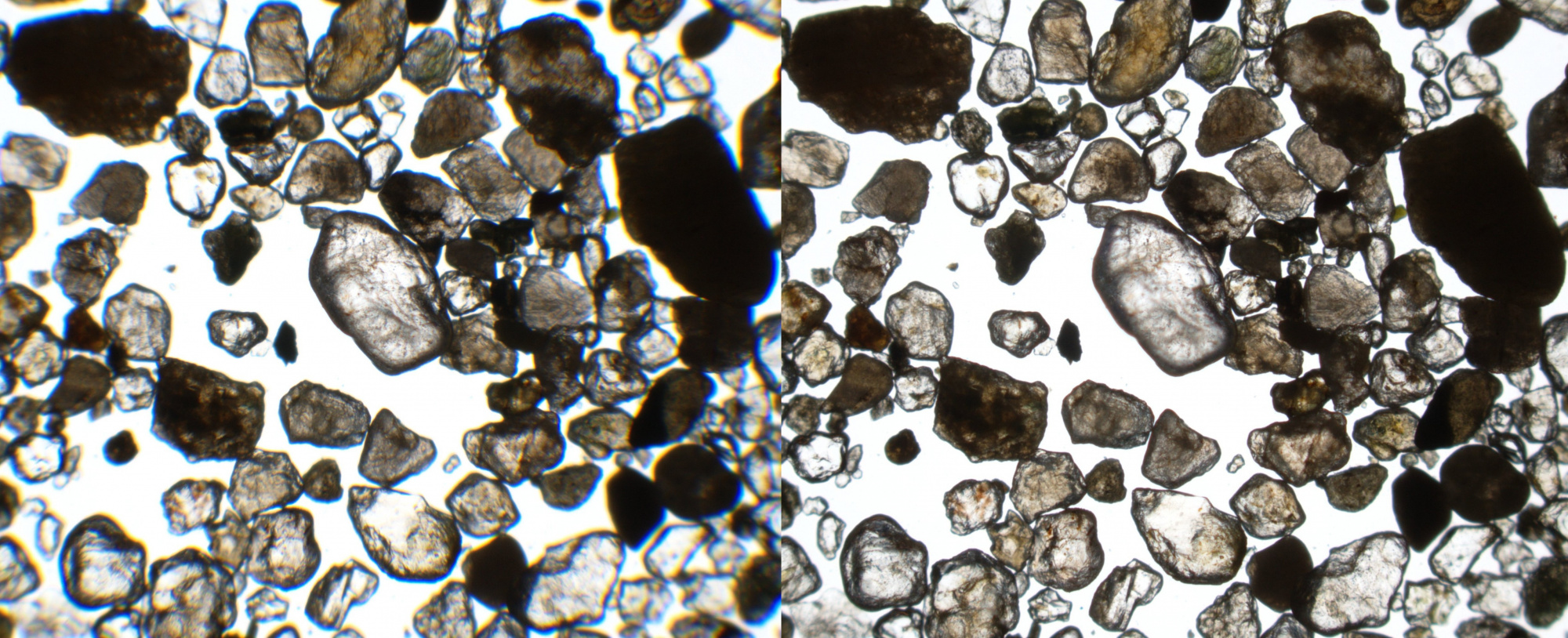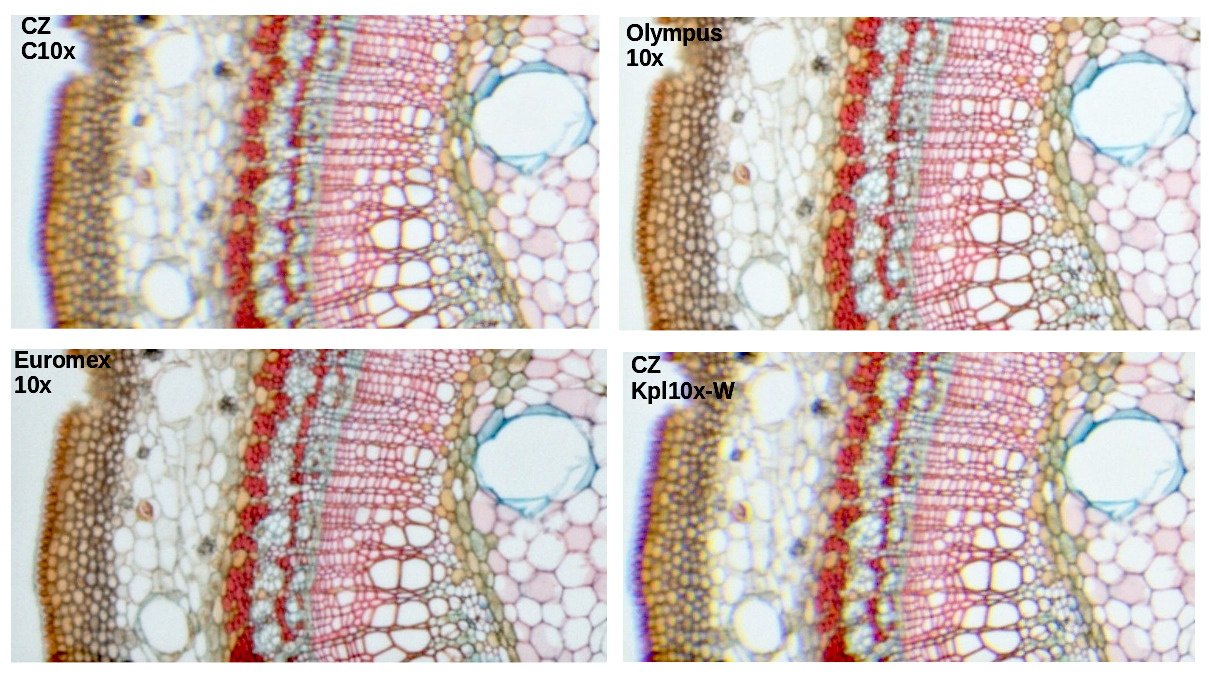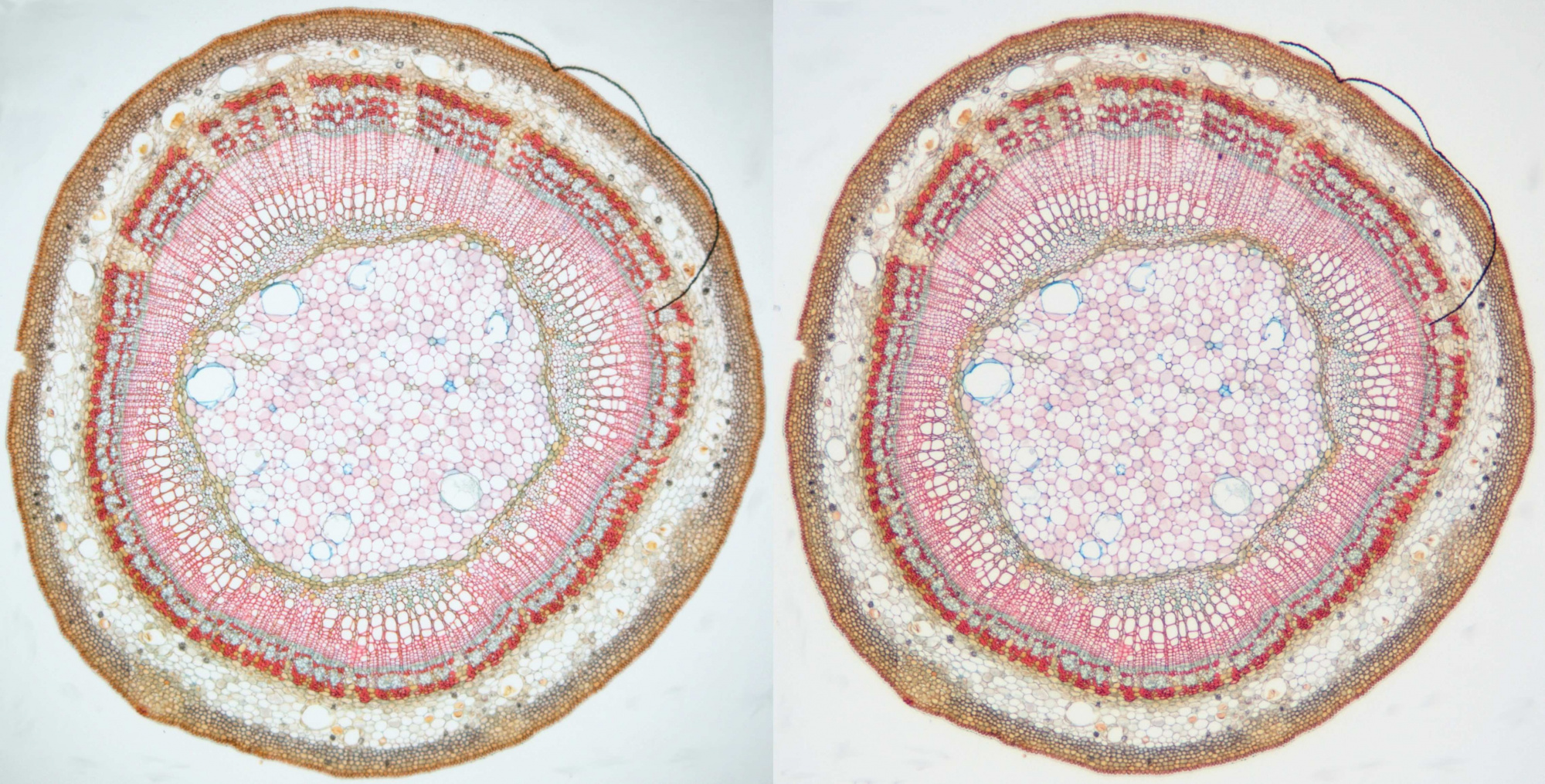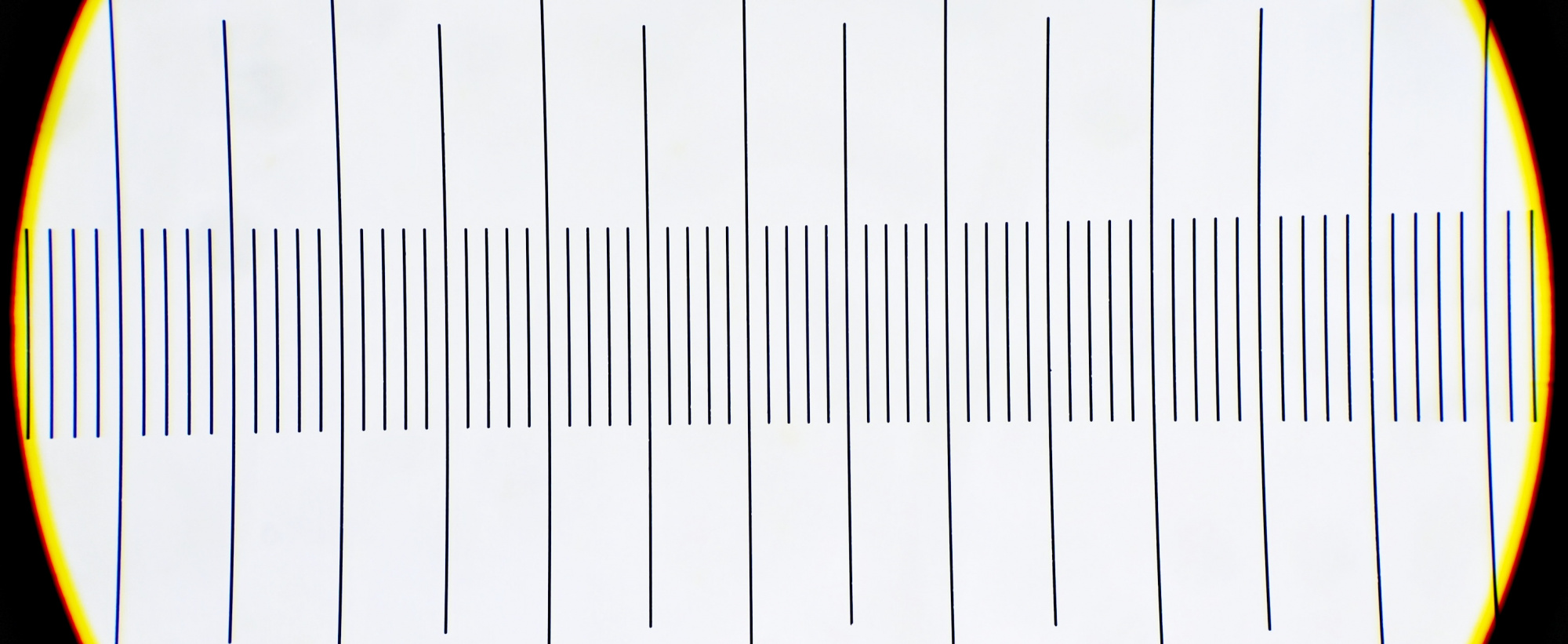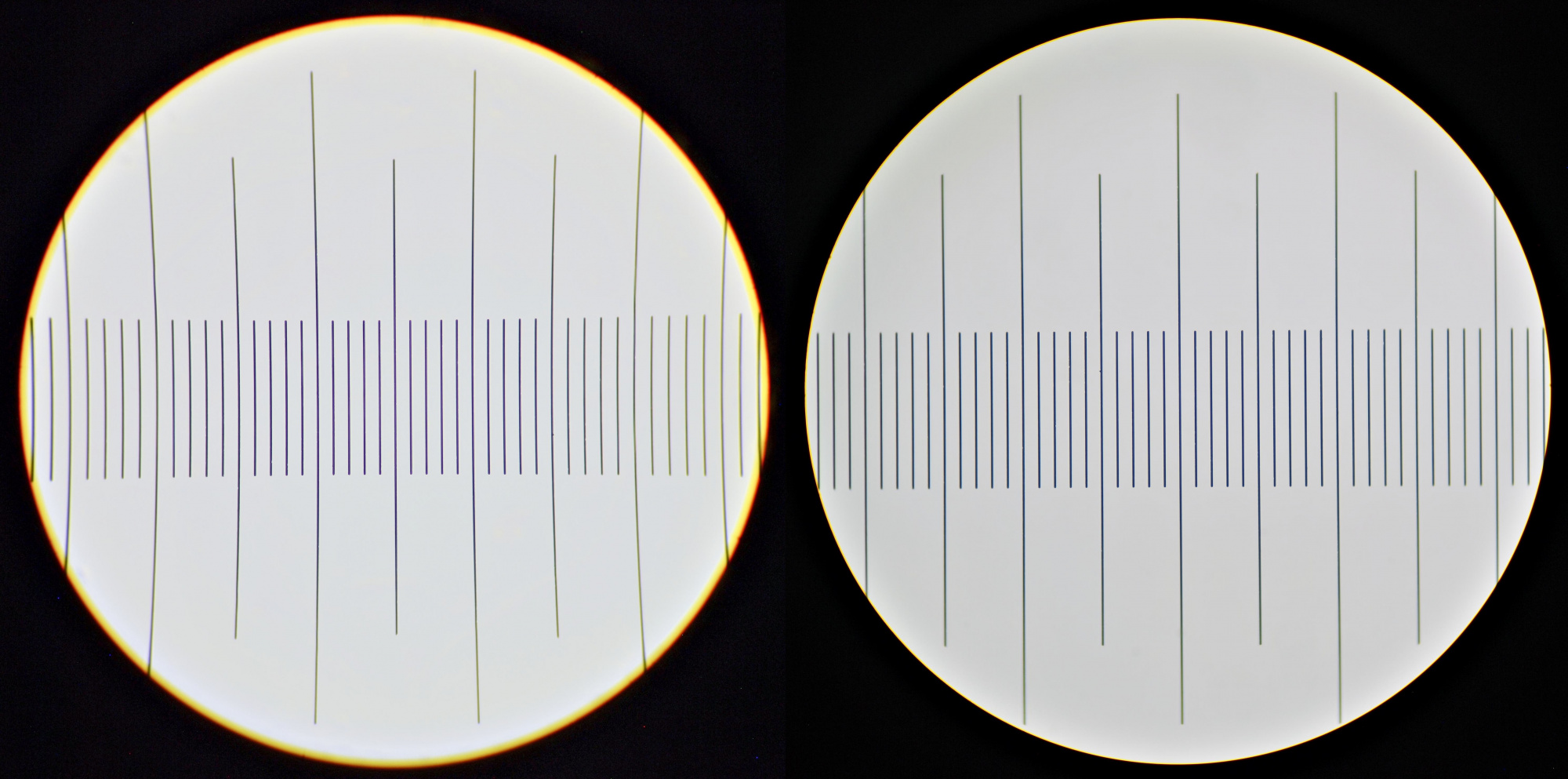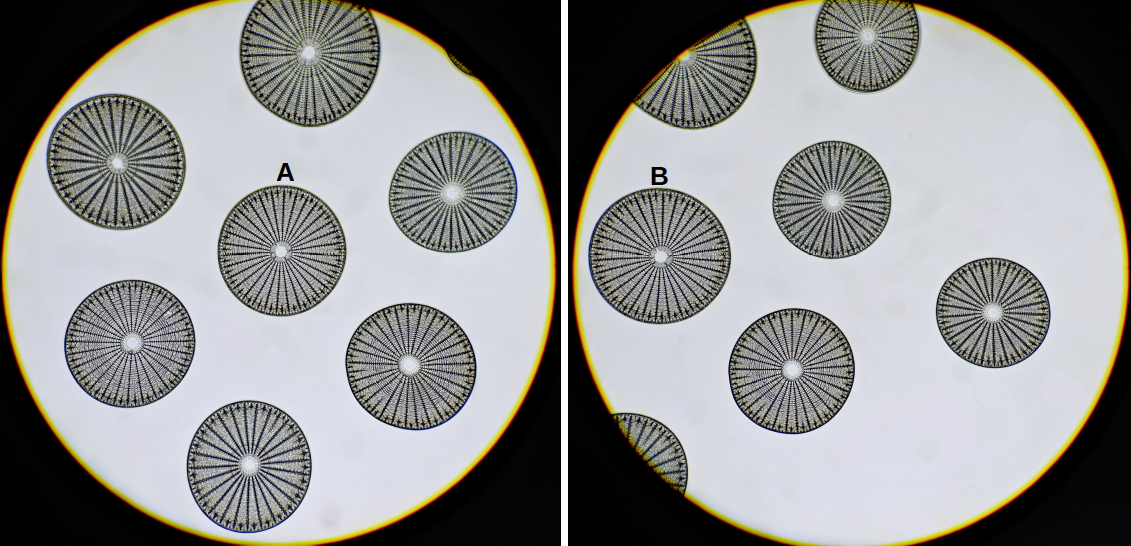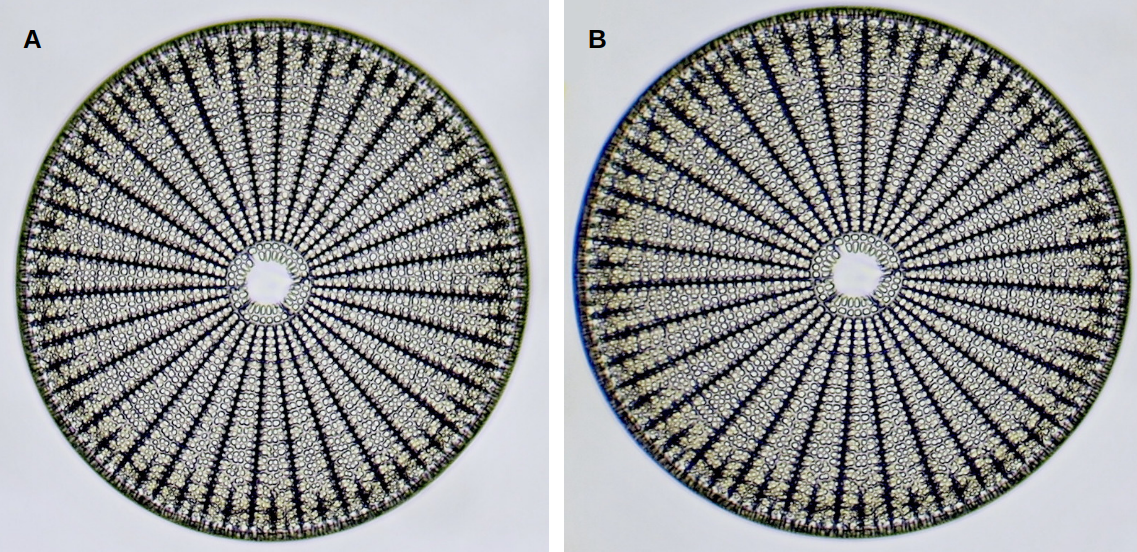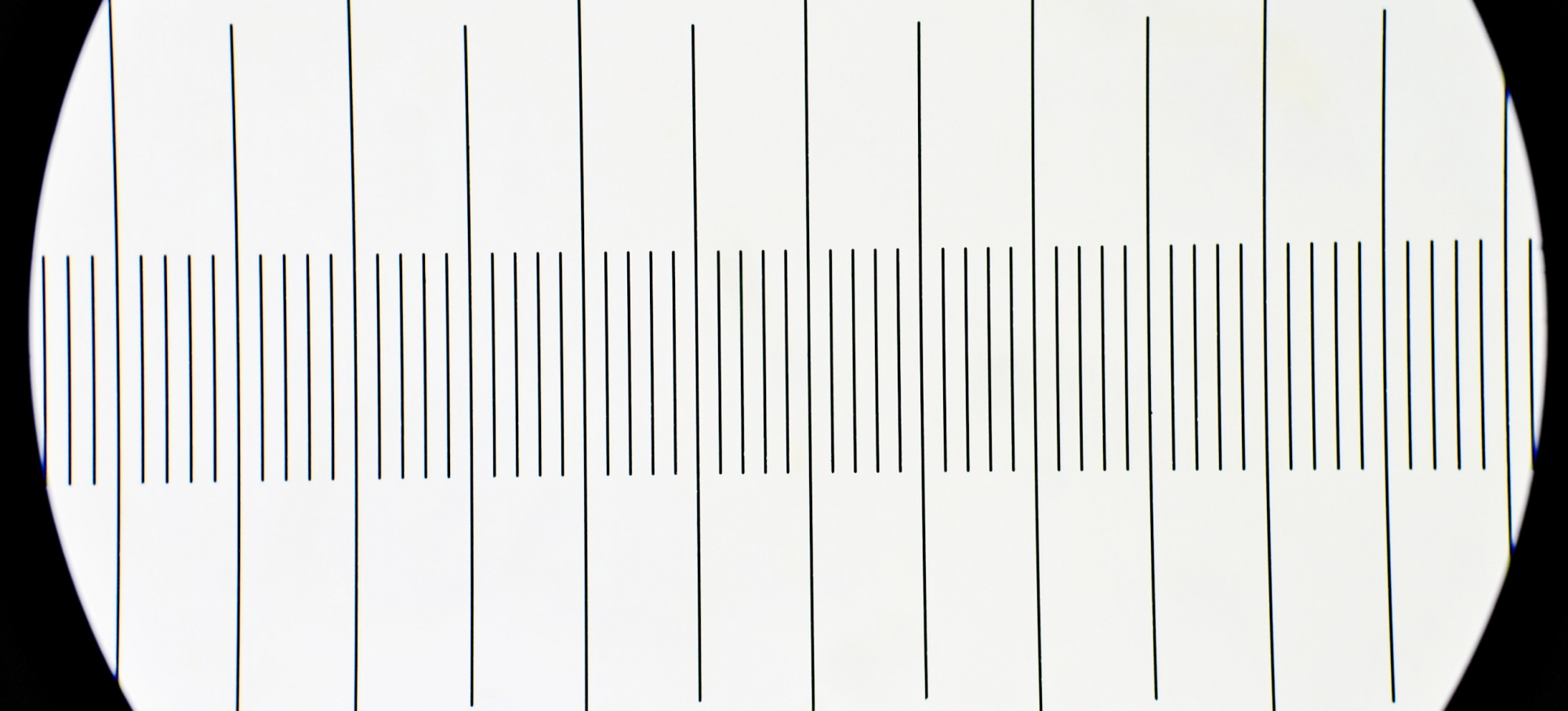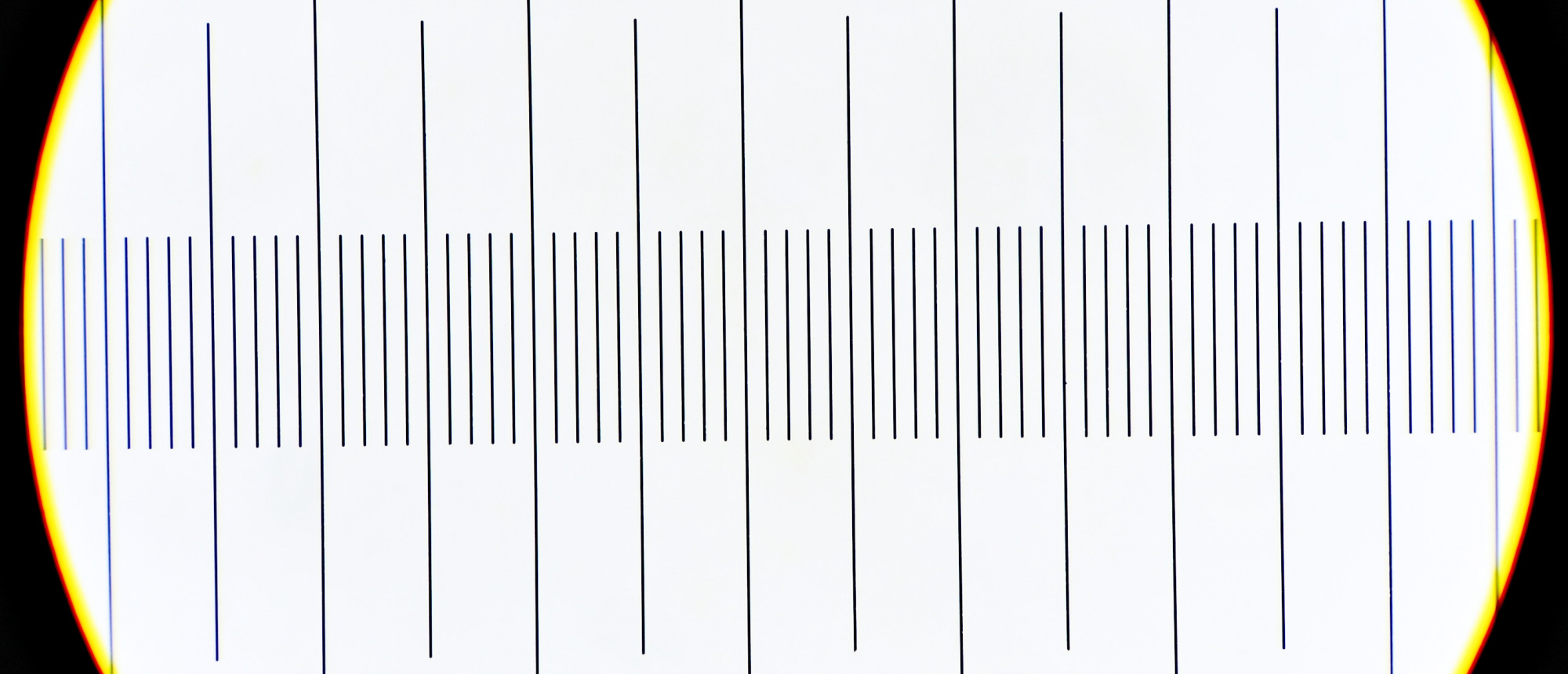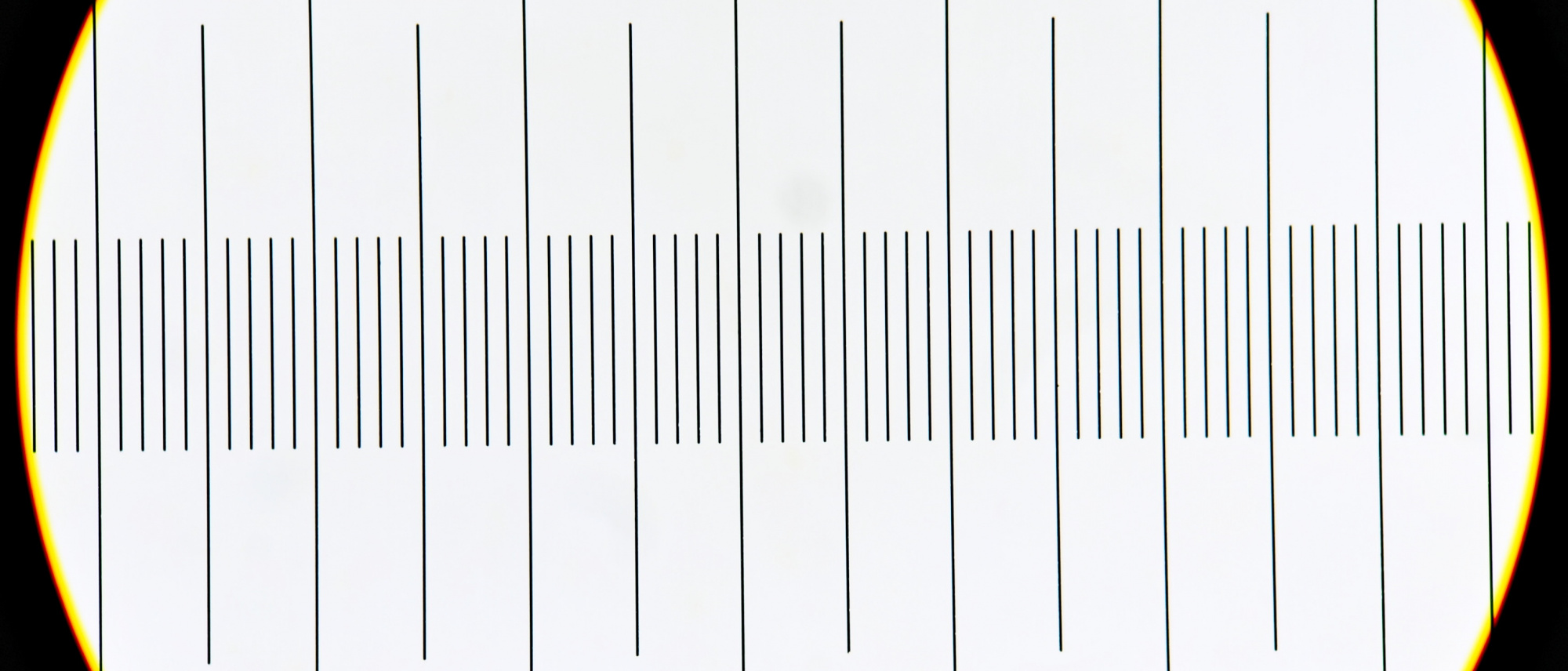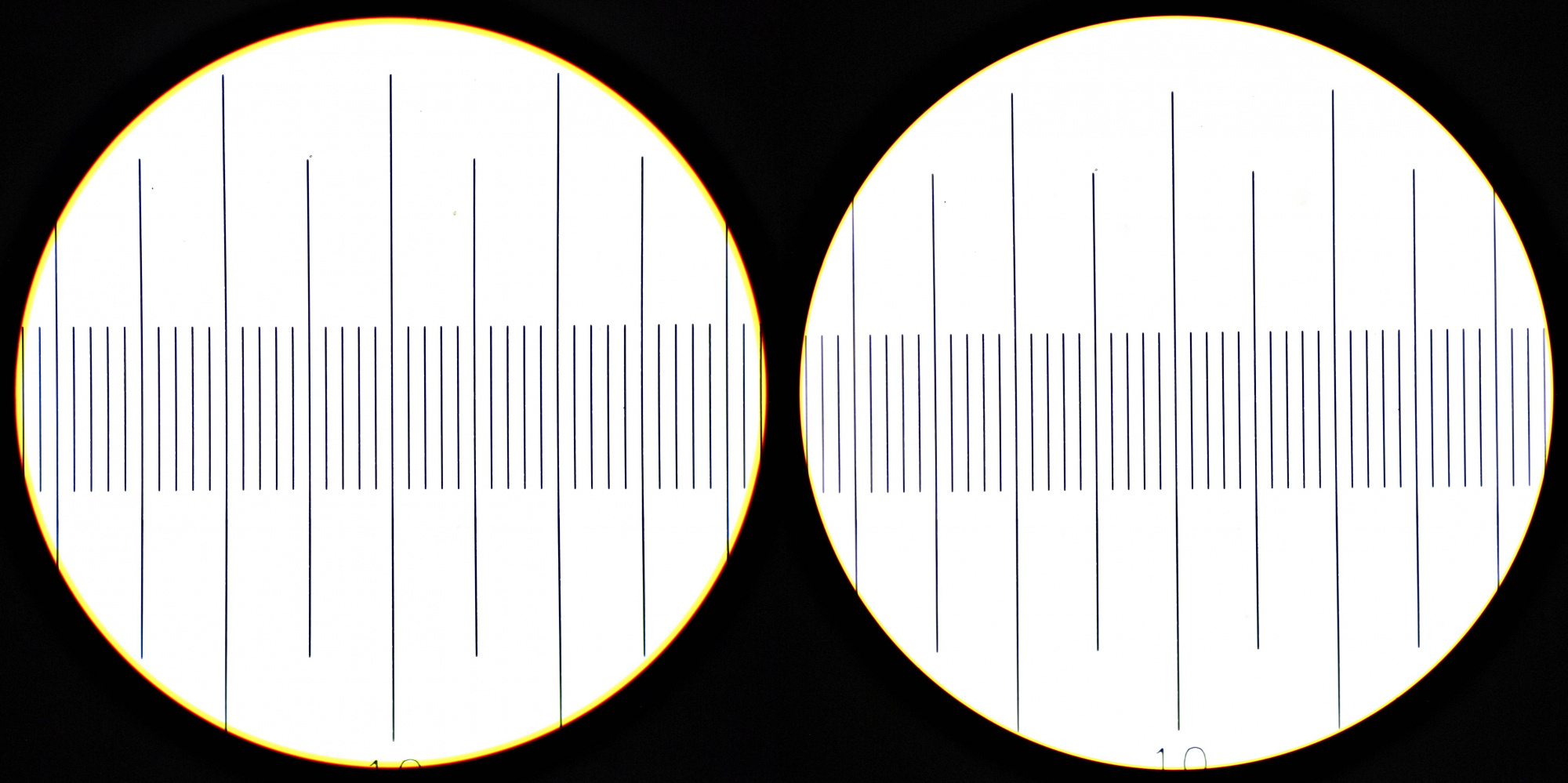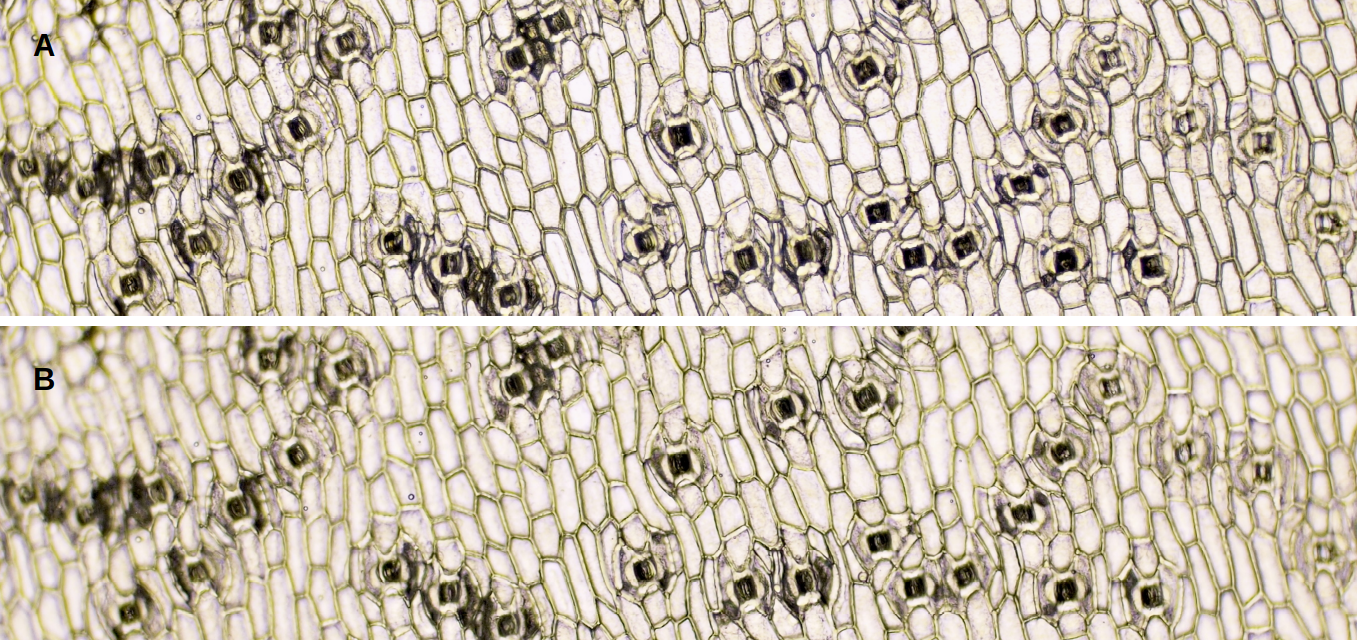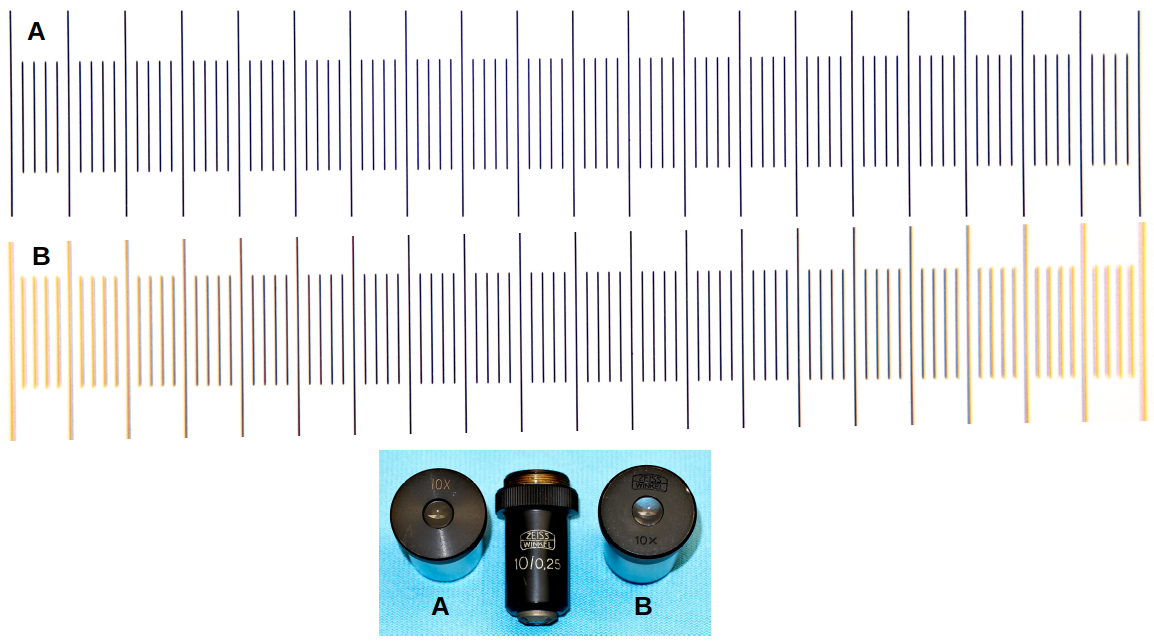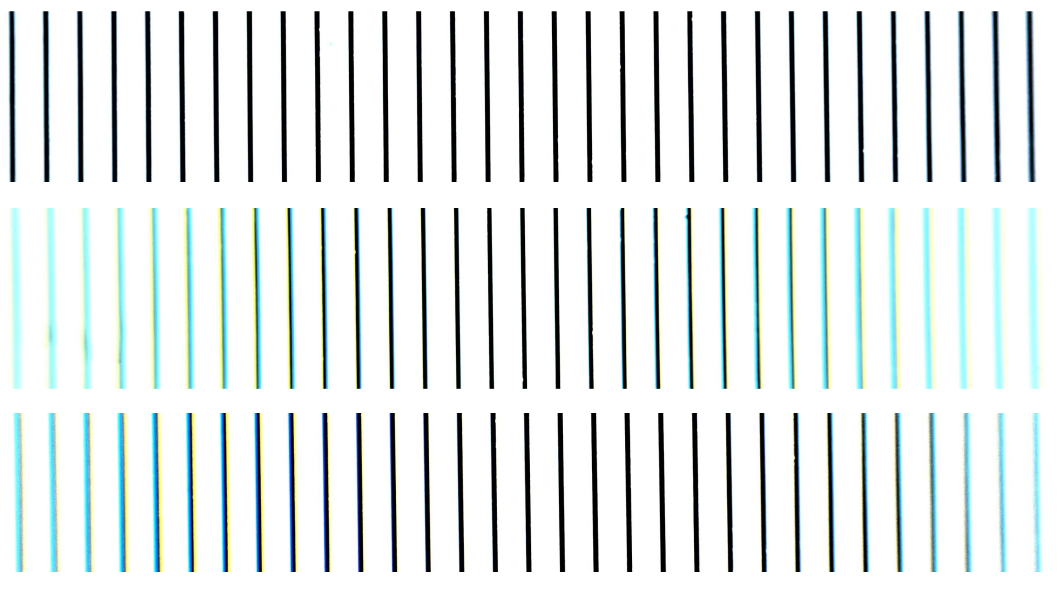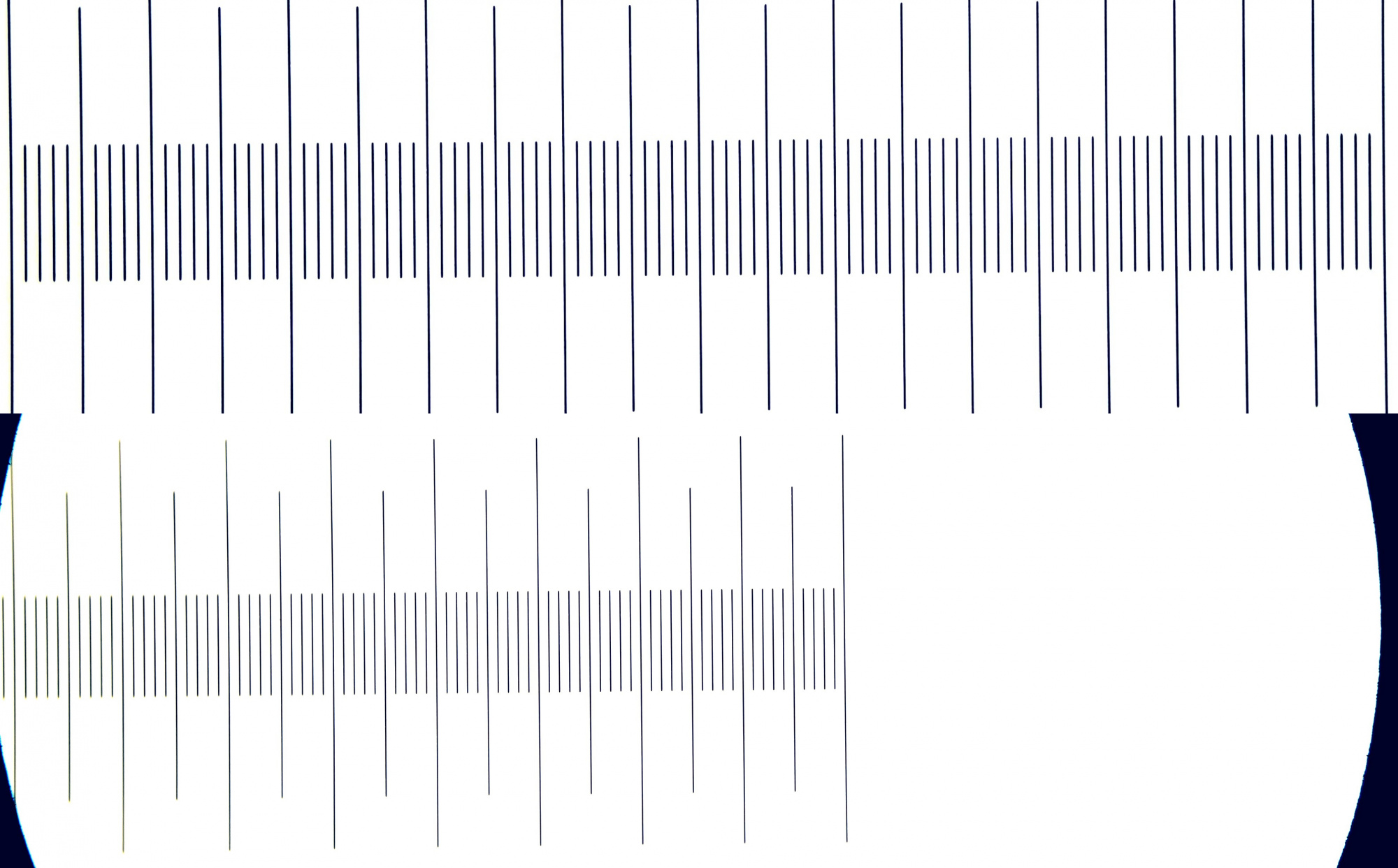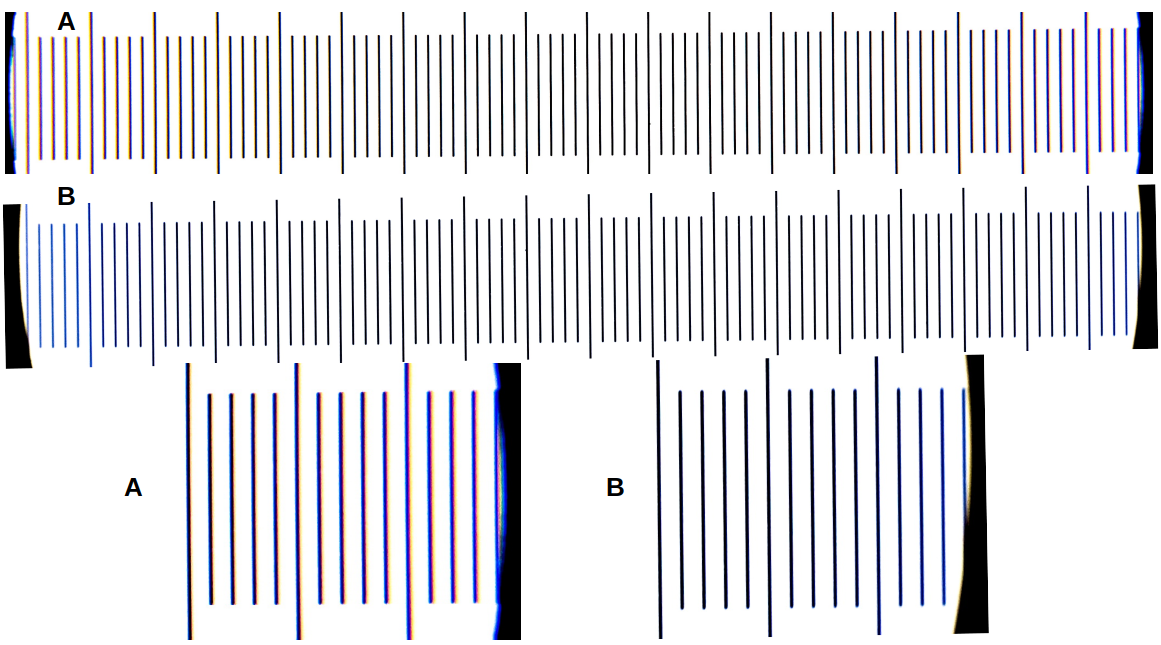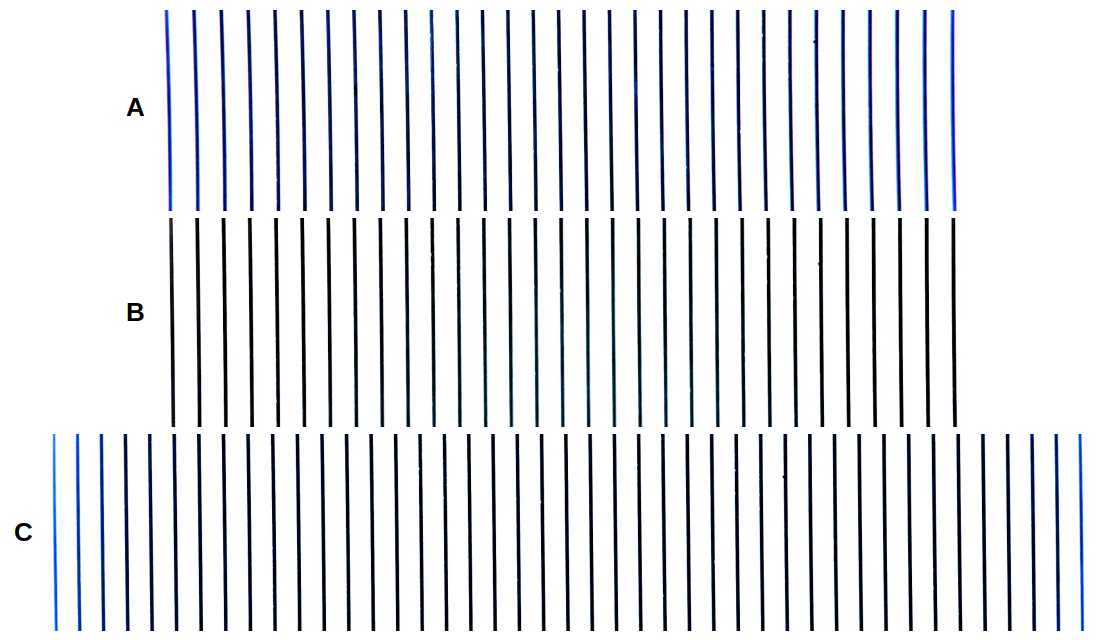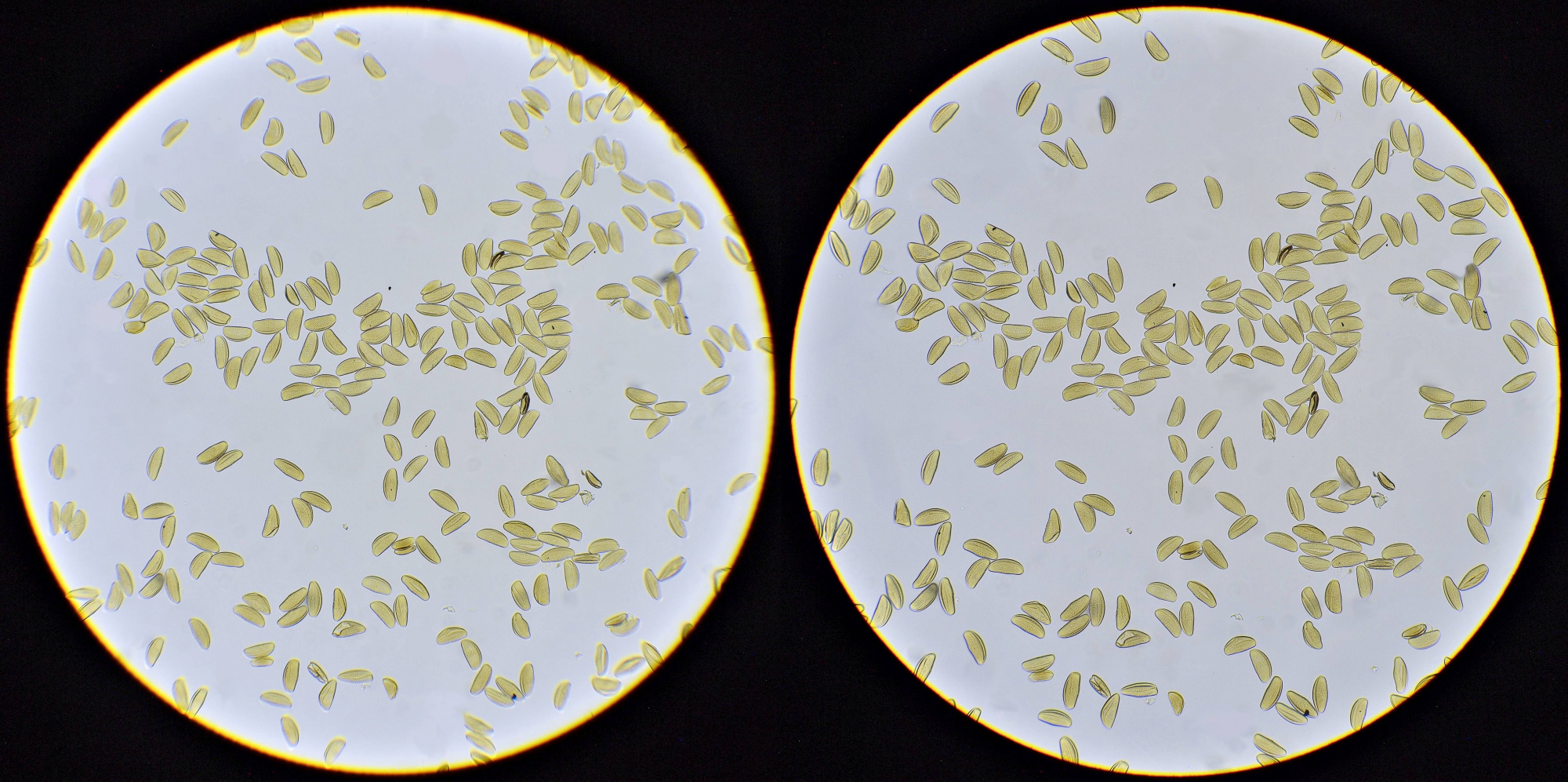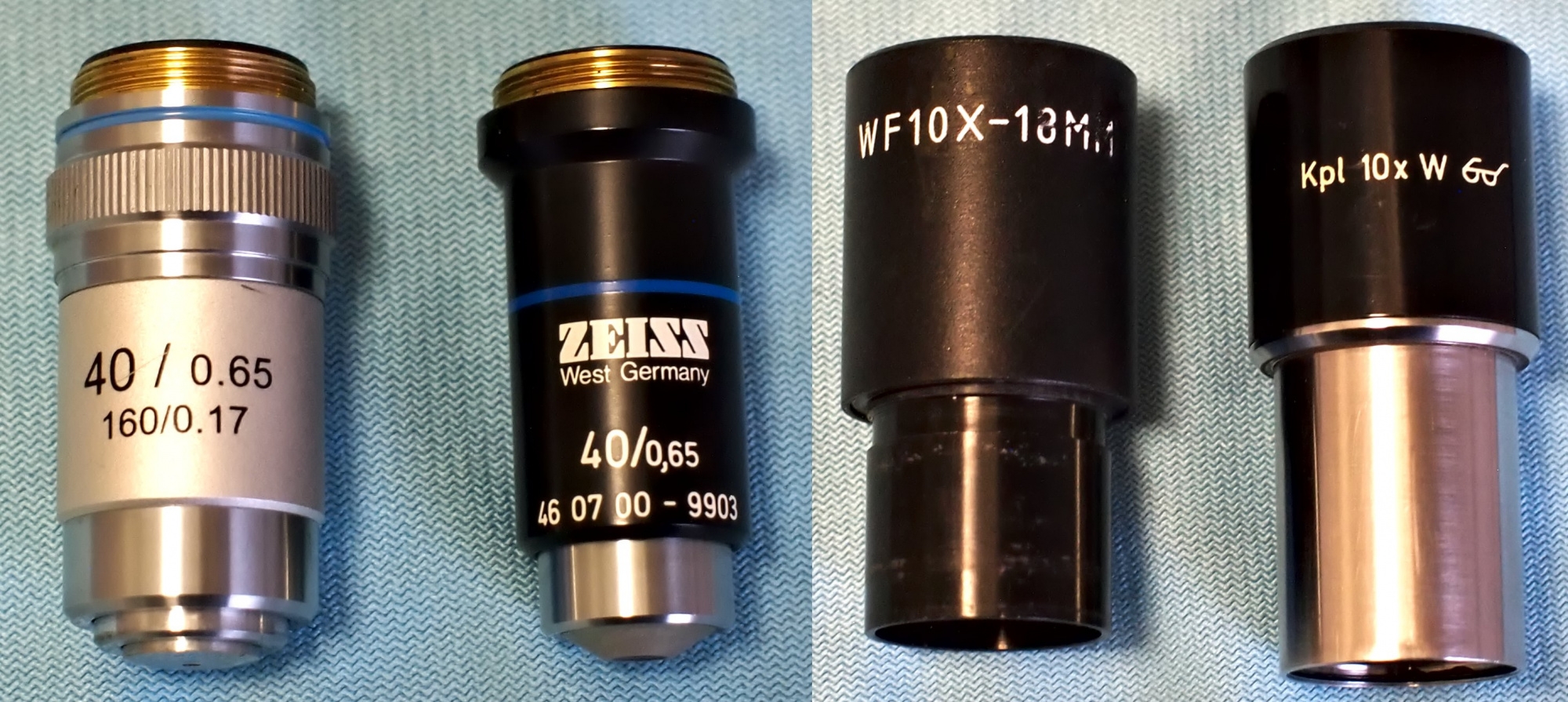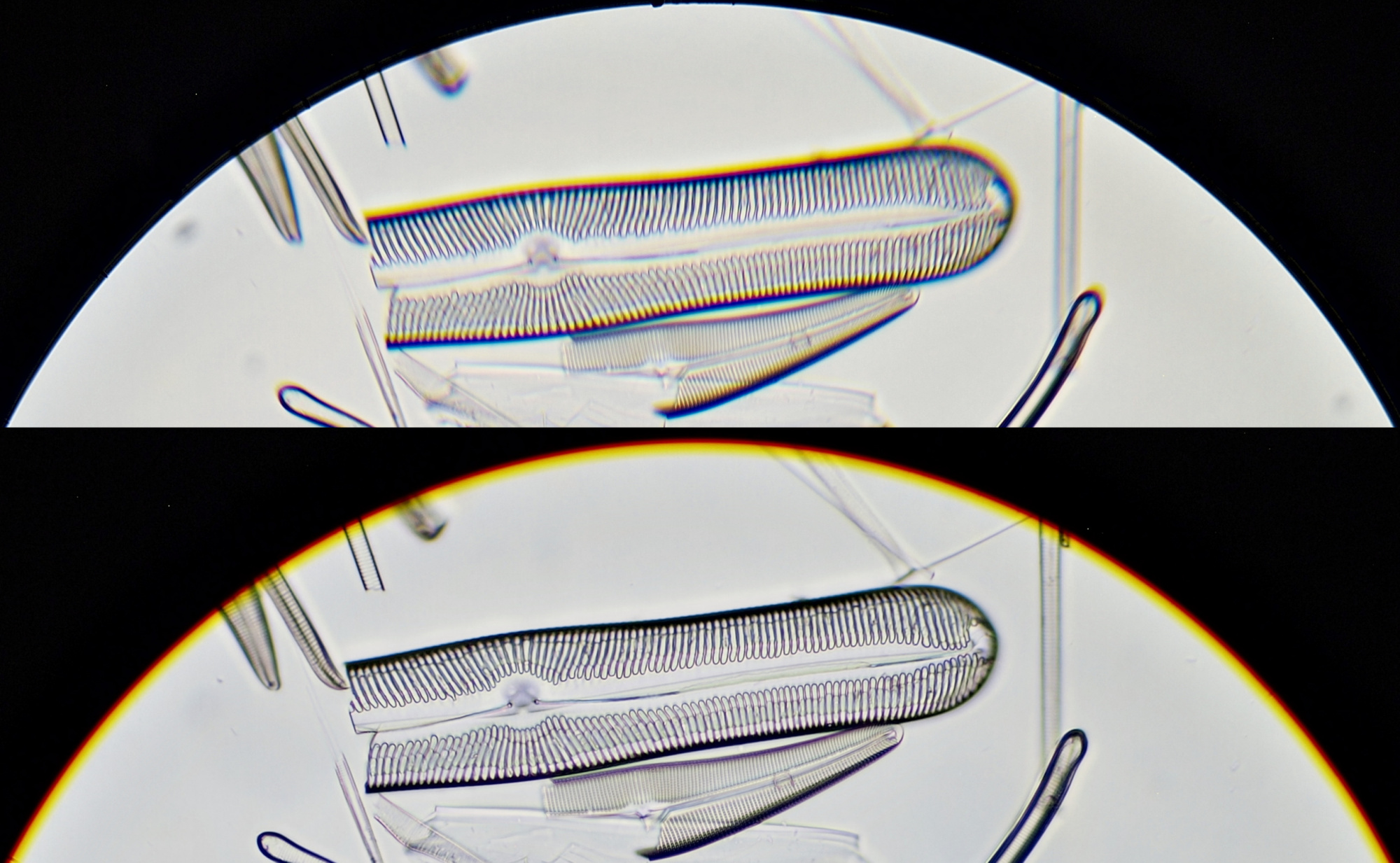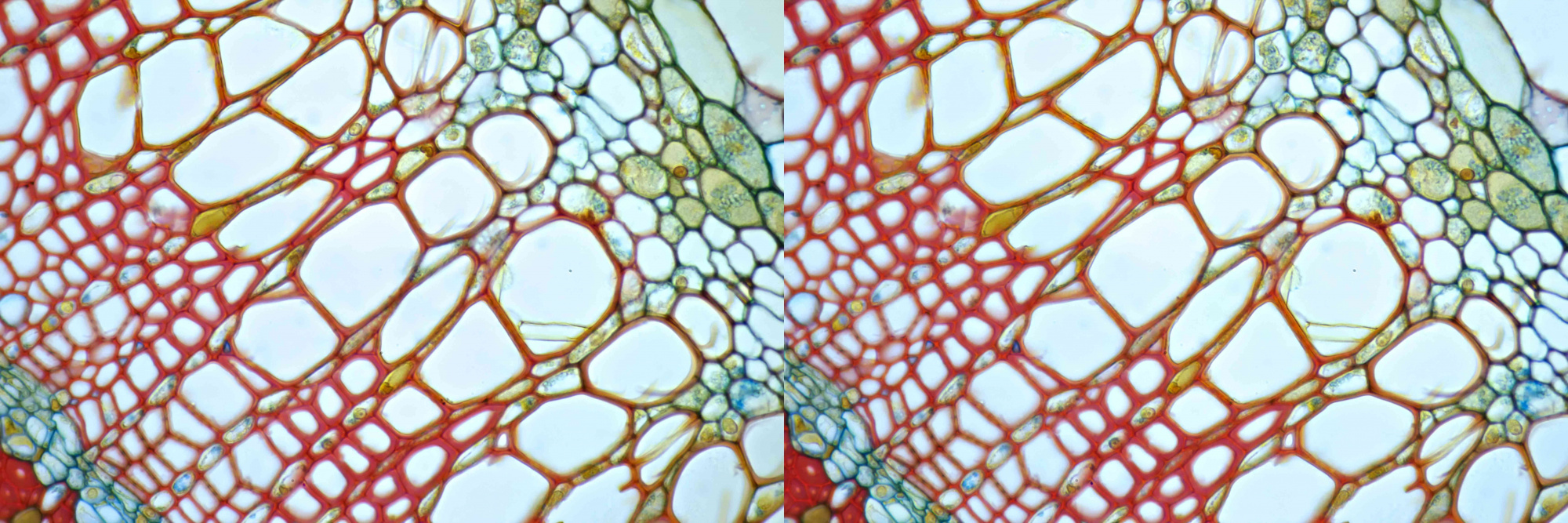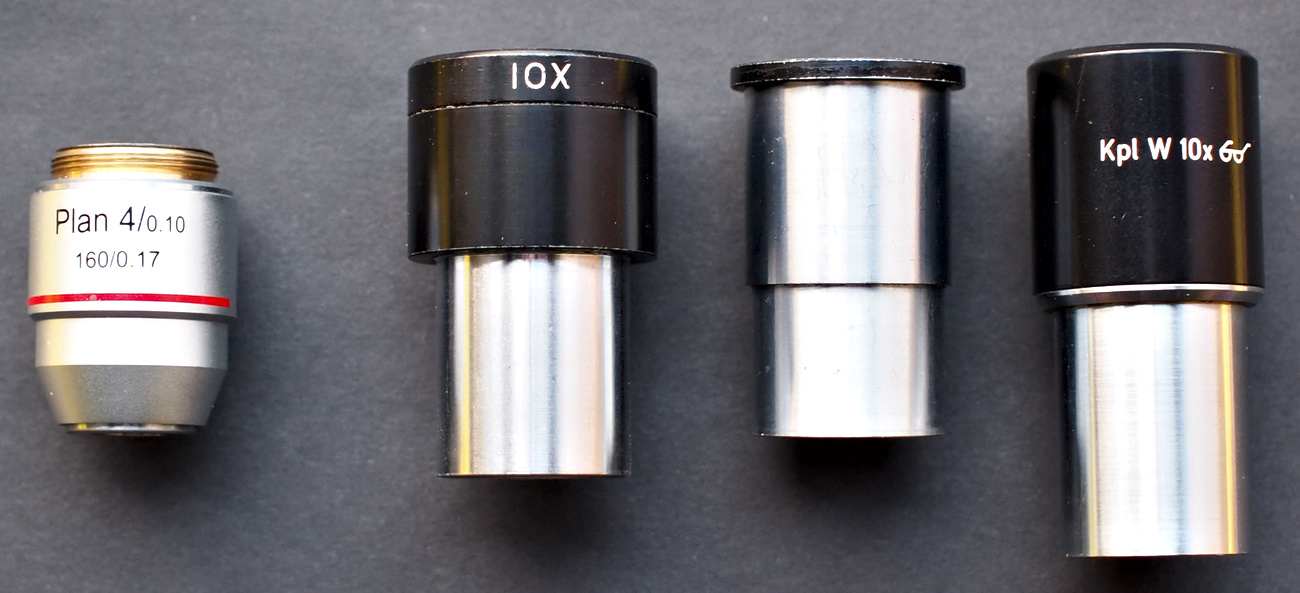To obtain a good microscopic image it is important that the objective and eyepiece are optically matched. In general, microscope manufacturers take care of this and most of the time it is best to use an objective with an eyepiece from the same manufacturer. But not always……. On a regular basis I see that certain combinations of objective and eyepiece from different brands give a better image than a combination from the same manufacturer.
Having the right match of objective and eyepiece is more important for photography than for visual observation. Especially during photography, optical aberrations become noticeable. While looking through a microscope, the brain partly corrects the errors in the image so that chromatic aberration, for example, is less noticeable. However, if one pays close attention to this, unfortunate combinations of eyepieces and objectives also become noticeable during visual observation and at a certain point they can be experienced as very disturbing. As a result, the viewing pleasure can be considerably tempered.
To determine if a certain objective-eyepiece combination is a good match, the image quality can be judged with a diatom slide or a stage micrometer. But also a stained or fresh plant slide can be used. With low power objectives like 2.5x - 10x, I find white sand to be a very useful material to detect chromatic aberrations.
For the tests I used an Olympus PEN E-PL1 camera with a Sigma 30 mm lens or an Olympus 17 mm Pancake lens as relay optics between eyepiece and sensor. With the Pancake lens it is possible to photograph the entire microscope field and to detect optical aberrations up to the edge of the field of view.
Compensating eyepieces
The image of most objectives calculated for a finite mechanical tube length (usually 160 or 170 mm) is not fully corrected and still contains residual errors that can be removed by using matching eyepieces. This was done with the help of so-called compensating eyepieces. An error opposite to the objectives has been built into these eyepieces so that they cancel each other out and the net result is a corrected image. Compensating eyepieces are often denoted by the letter 'C' (compensation), 'K' (Kompensation), 'P' (Photo) or other abbreviations with these letters. Carl Zeiss had C, Cpl, Kpl or KF written on their eyepieces and compensating Zeiss-Winkel eyepieces were labeled 'K'. For Carl Zeiss Jena it was 'K' or 'PK' and for Olympus 'P'. And Leitz had Periplan eyepieces. The designations thus differ per manufacturer and some compensating eyepieces have nothing written on them to indicate that they are corrective eyepieces, for example the Olympus WF10x eyepieces. An orange-yellow border around the field of view is often an indication that an eyepiece is compensating. However, this border is not always very visible and some compensating eyepieces give a blue border around the field of view. The best test is still the critical assessment of a stage micrometer or another slide that readily reveals chromatic aberration.
Often, not all objectives from the same manufacturer require the same amount of compensation. This is especially the case with older objectives from renowned manufacturers and recent no-name objectives. Here, it is often the case that the low power achromats (2.5x -10x) need little or no compensation. If a compensating eyepiece is used here, these objectives will be over-corrected, resulting in clear chromatic aberration. However, all better corrected objectives such as planachromats (plan) fluorite objectives or (plan) apochromats mostly need compensation. Because not all objectives required the same amount of correction, different types of eyepieces were supplied with a microscope. Usually, the simple Huygens eyepieces without any additional indication were intended for the low power achromats. However, Carl Zeiss had brought the compensation for all objectives to the same level. The same was the case when both Leitz and Olympus started producing 45 mm objectives. The older 37 mm lenses from Leitz and Olympus still needed different amounts of compensation.
Carl Zeiss Oberkochen
Carl Zeiss Oberkochen only made compensating eyepieces and they were designated C, Cpl, KF and Kpl. The C-eyepieces have the least correction and the Kpl eyepieces compensate the best. C-eyepieces were recommended for normal achromats, Cpl and KF for achromats / semi-planachromats and Kpl also for the better corrected (plan)Neofluars and (plan)apochromats. But actually Kpl eyepieces can be used for all objectives. With the Cpl (Compensations-Plan) and Kpl (Kompensations-Plan) eyepieces, a better plan-correction is achieved, so that a larger part of the field of view is in sharp focus. For photography there were special photo eyepieces, marked with 'FK' and 'S-Kpl'. The S-Kpl eyepieces were the best Carl Zeiss eyepieces ever and the asking price for these on the used market is still quite high.
There are also compensating eyepieces from Zeiss Opton (Opton optical Works Oberkochen). These eyepieces have a 'K' on them and were supplied with the Zeiss Opton Stativ W. However, the objectives and eyepieces for Stativ W are not widely distributed.
Zeiss had calculated the same amount of compensation for all objectives, except for the 3.2/0.07 achromat. This means that not a single eyepiece from Carl Zeiss Oberkochen gives satisfactory results with the 3.2 achromat. This lens hardly needs any compensation, and when using a correcting eyepiece, a very strong chromatic aberration is observed. It is a good example of an optical mismatch between objective and eyepiece from the same manufacturer. German microscopists sometimes refer to the 3.2/0.07 objective as "Flashenboden", which indicates quite clearly that the image is not great when used with one of the Carl Zeiss compensating eyepieces. But when this objective is combined with any non-compensating or less compensating eyepiece, the image is greatly improved. Weakly or non-compensating Huygens eyepieces from other manufacturers or unbranded WF eyepieces appear to work fine with the 3.2 achromat. Zeiss-Winkel 5x-10x eyepieces (not the 'K' version!) also work well, for those who do not want to deviate too much from Zeiss.
Sand grains photographed with a Carl Zeiss 3.2/0.07 objective. Left, a Carl Zeiss C10x eyepiece was used and right, an Olympus 10x eyepiece. The Olympus eyepiece barely compensates and the image is much better than the one obtained with the C10x eyepiece. Blue colour fringes can clearly be seen with the C10x eyepiece.
Section of a stained Tilia stem photographed with a Carl Zeiss 3.2/0.07 objective and with Olympus, Euromex and Carl Zeiss (CZ) eyepieces. With the CZ eyepieces, strong chromatic aberration is visible towards the edge.
Tilia stem photographed with two different Carl Zeiss low-power objectives. Left: 3.2/0.07 and Olympus 10x eyepiece. Right: Plan 2.5/0.08 and Kpl10xW eyepiece. The results are comparable due to fact that eyepieces with different compensation were used.
I tested the following eyepieces from Carl Zeiss Oberkochen: C10x, CPL W 10x, KF 10x and Kpl 10x W. Most disappointing in my opinion are the CPL eyepieces. These eyepieces show a clear pincushion distortion. No wonder that CPL eyepieces were sometimes called ‘Cheap Plastic Lenses’.......
Stage micrometer photographed with a Carl Zeiss Plan 25/0.45 and CPL W 10x eyepiece. The bars of the micrometer are curved at the edges indicating pincushion distortion.
Stage micrometer photographed with a Zeiss F40/0.65 objective. Left Cpl W10x eyepiece, right Leitz Periplan GF10x eyepiece (older version). With this objective, the pincushion distortion with the Cpl eyepiece becomes even more noticeable while an eyepiece from another brand gives a much better image.
The effect of pincushion distortion on an object lying at the edges of the field of view is demonstrated with the diatom Arachnoidiscus. The next figure shows the entire field of view of a slide with Arachnoidiscus. The specimen lying in the center of the field is then shifted to the edge of the field of view. Due to pincushion distortion of the CPL W 10x eyepiece, the diatom is distorted to an oval shape.
The Arachnoidiscus specimen in the middle (A) is shifted to the edge (B), thereby becoming oval shaped. In the left image, the distortion is also visible in the other specimens lying at the edge. Carl Zeiss Plan 25/0.45 and CPL W 10x.
Crops from the previous image. A: Arachnoidiscus located in the middle. B: the same specimen, but now shifted to the edge. In addition to oval distortion, chromatic aberration is visible.
I have experience with many eyepieces from different brands but I have rarely seen eyepieces that distort the image as much as the Cpl eyepieces.
In the following images, an object micrometer is photographed with the other eyepieces. Even with the simple C10x eyepiece, the image quality is better than with the CPL W 10x.
Stage micrometer photographed with Carl Zeiss Plan 25/0.45 and C10x eyepiece. Very little pincushion distortion is seen at the edges.
Stage micrometer photographed with Carl Zeiss Plan 25/0.45 and KF 10x eyepiece. No pincushion distortion, but slightly less plan correction than with a Kpl 10x W eyepiece.
Stage micrometer photographed with Carl Zeiss Plan 25/0.45 and Kpl 10xW eyepiece. Best correction, no pincushion distortion and optimal plan correction.
Crops from the previous images showing the object micrometer at the far left of the field of view. Only with the Kpl 10x W eyepiece, no aberrations are seen over the entire field of view.
The next comparison is a comparison between a Kpl10xW eyepiece, the best eyepiece from Zeiss, and a Leitz Periplan GF10x (TL 170 mm). The Periplan eyepiece appears to harmonize quite well with Zeiss objectives. However, the plan correction of the Kpl10xW eyepiece is slightly better. For best results, the Periplan eyepiece should be raised in the tube until the image is parfocal with the Zeiss eyepiece. But without raising the eyepiece, the picture is still quite good, as the comparison below shows.
Stage micrometer photographed with Zeiss plan 40/0.65. A Zeiss Kpl10xW eyepiece was used on the left, a Leitz Periplan GF10x (TL 170 mm) on the right. The results are comparable. The Periplan eyepiece was not placed at an elevated position in the tube, so the field of view is a very small fraction larger than that of the Kpl10xW eyepiece.
In the following test I compared three eyepieces: Zeiss Kpl10xW, Zeiss KF10x and Leitz Periplan GF10x (170mm). I used white sand as material and I photographed it with a Carl Zeiss Neofluar 6.3/0.20. Here too, the Periplan eyepiece appears to give a reasonably good image, which I think is better than the image obtained from the Zeiss KF10x eyepiece.
White sand photographed with Carl Zeiss Neofluar 6.3/0.20 and Zeiss Kpl10xW (left), Zeiss KF10x (center) and Leitz Periplan GF10x (right). The Leitz eyepiece was placed slightly higher in the tube so that it was parfocal with the Zeiss eyepieces. The photos were taken with a Zeiss Standard Junior and the Olympus PEN E-Pl1 camera with Olympus 17 mm lens.
In summary, it can be said that with Carl Zeiss / Zeiss objectives for 160 mm mechanical tube length Kpl eyepieces are best used, both for visual observation and for afocal photography. The only exception is the 3.2/0.07 achromat which is best used in combination with any non-compensating eyepiece. Furthermore, Leitz Periplan GF10x eyepieces (TL170 mm) can be used quite satisfactory with Zeiss objectives.
Zeiss-Winkel
At Zeiss-Winkel, the required correction of the various objectives had not yet been brought to the same level. Objectives ≤ 10/0.25 hardly needed compensation. Eyepieces with extra compensation were indicated with 'K', while Kpl eyepieces were also made later, just before Zeiss-Winkel changed over to Carl Zeiss. On eyepieces that compensate less, there is nothing written besides the magnification. These weakly compensating eyepieces are a compromise when used with all objective magnifications. Some unbranded Huygens eyepieces appear to provide a better image with objectives ≤ 10/0.25 than the original Zeiss-Winkel eyepieces, this difference can be clearly demonstrated photographically. At the same time, better results are achieved when compensating Olympus eyepieces (e.g. WF10x or P10x) are used with 40/0.65 achromats. But in general, the normal Zeiss-Winkel 8x eyepieces (without 'K') are quite useful for visual observation with ≤ 40/0.65 objectives. The Zeiss-Winkel 8x eyepieces do not work satisfactorily with Zeiss-Winkel 100/1.3 objectives and more compensation must be applied which can be achieved with Zeiss-Winkel K8x or Carl Zeiss C8x eyepieces. If you want to get the best out of all Zeiss-Winkel objectives, you will have to change eyepieces.
Epidermis from a leaf of Yucca filamentosa photographed with a Zeiss-Winkel 10/0.25 objective. A: Euromex 10x eyepiece. B: Zeiss-Winkel 8x eyepiece. In the lower picture, clear spherical aberration can be seen towards the edges; a substantial part of the specimen is not in sharp focus.
Stage micrometer photographed with a Zeiss-Winkel 10/0.25: A: no-name 10x eyepiece. B: Zeiss-Winkel 10x eyepiece. With the no-name eyepiece, this old achromat shows the entire micrometer in sharp focus!
The following tests show that Zeiss-Winkel 40/0.65 achromats give a better image with an Olympus P10x eyepiece than with original Zeiss-Winkel K8x and 10x eyepieces. For the higher magnification objectives of Zeiss-Winkel I mostly use Olympus WF10x eyepieces for visual observation. These have the same compensation as the P10x eyepieces and they also have a larger field of view with field number 18. To maintain parfocality the Olympus eyepieces have to be placed at a raised position in the tube by about 10 mm.
Stage micrometer photographed with a Zeiss-Winkel 40/0.65. The eyepieces used were, from top to bottom: Olympus P10x, Zeiss-Winkel 10x and Zeiss-Winkel K8x. Chromatic aberration is clearly visible at the edges when using Zeiss-Winkel eyepieces and a better image is obtained with compensating Olympus eyepieces.
Also the older Zeiss-Winkel achromats of 39 mm parfocal length work very nicely with eyepieces from other manufacturers. Both the 42/0.65 and 42/0.85 objectives give minimal artefacts in combination with a Olympus P10x eyepiece while the 10/0.25 achromat works perfectly with a Euromex 10x Huygens eyepiece.
Zeiss-Winkel achromat 42/0.85 gives very little chromatic aberration in combination with a Olympus P10x eyepiece.
Stage micrometer photographed with Zeiss-Winkel 10/0.25, 39 mm parfocal lenght. The eyepiece used was a Euromex 10x Huygens eyepiece. No significant chromatic aberration is visible. In the lower picture, the objectmicrometer is in sharp focus from the middle to the edge of the field of view.
Eyepieces for Olympus 37 mm objectives
Olympus microscopes with 37 mm objectives were equipped with different types of eyepieces. Horseshoe stands were often supplied with 2 or 3 eyepieces such as a 5x, 10x and a P10x eyepiece. In addition to these standard magnifications, there were 7x, P7x, 15x and P15x eyepieces. Binocular microscopes were fitted with wide-angle WF10x eyepieces. The P and WF eyepieces have the highest degree of correction and are suitable for the better corrected objectives, planachromats and achromats with higher magnifications. For lower power achromats there are the regular Huygens eyepieces 5x, 7x and 10x. When there is a ‘P’ written on the eyepiece it means that it is a photo eyepiece which is well corrected.
Stage micrometer photographed with an Olympus 10/0.25 objective. A: Olympus 10x eyepiece. B: Olympus P10x eyepiece; chromatic aberration caused by over-correction can be seen at the edges.
Stage micrometer photographed with an Olympus plan 20/0.40. A: Olympus 7x eyepiece. B: Olympus P7x eyepiece. Clear chromatic aberration is seen at the edges with the 7x eyepiece. The plan 20/0.40 objective clearly needs compensation.
Stage micrometer photographed with an Olympus PL 40/0.65 and three different Olympus eyepieces. Chromatic aberration and slight pincushion distortion is visible at the edges with an Olympus 10x eyepiece (A). Better correction is achieved with an Olympus P10x (B) and Olympus WF10x (C) eyepiece. P10 and WF10x eyepieces have a comparable correction, but the field of view is considerably larger with the WF10x.
I own a set of unbranded eyepieces that only have 8xP written on them. These seem to harmonize very well with Olympus 37 mm objectievs, as the image below shows.
The combination of an Olympus PL 40/0.65 objective and an unbranded 8xP eyepiece turns out to be a good match.
When Olympus introduced the objectives with 45 mm parfocal length, the so-called LB (Long Barrel) objectives, other eyepieces were used. Among these new eyepieces were the CWHK10x eyepieces. I own a few copies of the type CWHK10x-T/18L. These eyepieces also work well with 37mm Olympus objectives. I was somewhat surprised to discover that they harmonize even better with 37mm objectives than the WF10x eyepieces that were actually intended for them. In the test below, I compared the two different eyepieces with each other and the CWHK10x appears to perform a better plan correction, so that the image with a plan-objective is in focus right up to the edge.
Pollen of Clivia miniata photographed with Olympus Plan 10/0.25 (37 mm length). Left: Olympus WF10x eyepiece. Right: Olympus CWHK10x-T/18L eyepiece. The right image shows a better plan correction, the diameter of the field of view is minimally smaller. Camera: Olympus PEN E-PL1 with 17mm camera lens.
No-name optics
There are quite a few companies that import cheap microscopes and optical parts from China. On the eyepieces and objectives of these microscopes there is never written a name of a manufacturer, at most the name of the importer. The simpler microscopes intended for educational purposes usually have normal achromats that are calculated for a mechanical tube length of 160 mm and are often equipped with wide-field (WF) eyepieces that do not or hardly compensate the residual errors from higher power objectives. Only from the 4/0.10 and 10/0.25 achromats, a reasonable image can be expected. With objectives 40/0.65 and of higher power, the image with such eyepieces is noticeably worse. Sometimes it is claimed that the higher power objectives on such microscopes are not convincing. This is often true when the unbranded eyepieces that come with it are used. As soon as compensating eyepieces are used, a strong improvement is seen. My experience is that higher power no-name objectives can provide good images when compensating eyepieces from Olympus (WF or P eyepieces) or Carl Zeiss (for example Kpl eyepieces) are used. The following tests were done with a no-name 40/0.65 achromat that was attached to a very basic high school microscope. The lens was also compared with a 160 mm achromat from a later period of Zeiss.
Left: no-name and Zeiss 40/0.65 achromat. Right: no-name WF eyepiece and Carl Zeiss Kpl10xW eyepiece. These types of no-name objectives are often found on Chinese import microscopes from the lower price range.
Diatoms near the edge of the field of view photographed with the no-name 40/0.65 objective. Upper image: the corresponding WF10x eyepiece was used. Lower image: a Carl Zeiss Kpl10xW eyepiece was used. In the upper image, a strong chromatic aberration and distortion are visible.
I have compared the no-name objective with various Zeiss achromats and I must conclude that this lens is just as good as the black Zeiss achromat from later times.
Tilia stem section. Left: no-name 40/0.65 achromat. Right: the black Zeiss 40/0.65 achromat. In both cases a Kpl10x eyepiece was used. There is hardly any difference visible, contrast and colour rendering are comparable.
All planachromats of renowned brands do need compensation. With unbranded optics, this does not always have to be the case. I have a no-name plan 4/0.10 objective that clearly doesn't need any compensation. I tested the lens with a non-compensating unbranded WF10x eyepiece, an Olympus WF10x eyepiece and a Carl Zeiss Kpl10xW eyepiece, all with field number 18. The last two eyepieces are of course correcting eyepieces, which can be seen from the yellow-orange border around the field of view. As material for the test I used white sand. When testing low power objectives, white sand is excellent material so visualise chromatic aberrations.
No-name plan 4/0.10 objective and three wide-field eyepieces with, from left to right, unbranded 10x, Olympus WF10x and Carl Zeiss Kpl10x W.
White sand photographed with unbranded plan 4/0.10 objective. The eyepieces used were: unbranded 10x (left), Olympus WF10x (middle) and Carl Zeiss Kpl10x W (right). Note the yellow-orange border around the field of view with the compensating eyepieces. The left image is as it should be. In the other two images, chromatic aberration and distortion are clearly visible at the edge. Because image quality is poor at the edges, the subjective impression of these photos is completely ruined.
Conclusion
Combinations of objectives and eyepieces from the same manufacturer do not always give the best results. Especially with plain achromats, it is recommended to experiment a bit. To get the best out of achromats, different eyepieces are required. Higher power achromats need compensation whereas low power achromats do not or need less correction. The proper objective-eyepiece combination is best determined experimentally and by critically assessing the microscopic image with suitable test slides.
